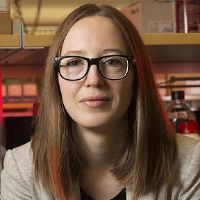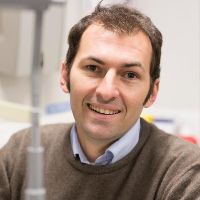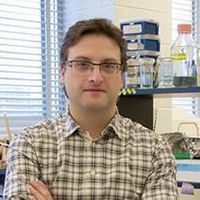USH1F Research
Gene: PCDH15
Year Identified: 2001
Each research project listed below will include a graphic of the research continuum. The gold box indicates where this project falls on the continuum, illustrating its progress towards reaching people living with Usher syndrome, from "Bench to Bedside."
Click here to learn more about the different stages in the research continuum.
Rate of Progression of PCDH15-Related Retinal Degeneration in Usher Syndrome 1F (RUSH1F)

The Usher 1F Collaborative, a family-founded nonprofit and the Foundation Fighting Blindness are partnering to launch a natural history study, “Rate of Progression of PCDH15-Related Retinal Degeneration in Usher Syndrome 1F (RUSH1F).” The Marjorie C. Adams Trust will provide additional funding for the study. This natural history study will follow 40 individuals with USH1F for four years. Its primary goal is to identify outcome measures in individuals with the PCDH15 mutation which causes USH1F. These outcome measures can be used in future clinical trials. The Jaeb Center for Health Research in Tampa Florida is the coordinating center. Dr. Katarina Stingl of the University of Tübingen in Germany will serve as the study chair. The study began enrolling participants in May 2021.
Foundation Fighting Blindness Press Release
Link to study details on ClinicalTrials.gov
Zebrafish Model for USH1F


Monte Westerfield, Ph.D.:
Institute of Neuroscience at University of Oregon
Westerfield and his team at the Institute of Neuroscience and Department of Biology at the University of Oregon are focusing on creating zebrafish models of multiple Usher syndrome mutations including USH1F. The Usher 1F Collaborative has funded the creation of a zebrafish model with USH1F R245X mutation that is carried by approximately 2% of those with Ashkenazi Jewish descent. Westerfield and his team, including Jennifer Phillips Ph.D. are now testing of drugs on the zebrafish that have potential to halt or slow the progression of vision loss, with promising results for one potent antioxidant.
Dr. Monte Westerfield's Lab Page
Mouse Model with USH1F


Zubair Ahmed, Ph.D.:
University of Maryland School of Medicine
Ahmed and his team at the University of Maryland have developed a mouse model of the most prevalent USH1F mutation. They are now using the mouse model to test gene therapies developed by labs at the University of Western Australia and the University of Pittsburgh. Dr. Ahmed’s team is testing two compounds, both of which are showing efficacy in their mouse model.
Gene Therapy for USH1F


Edwin Stone, M.D., Ph.D.:
University of Iowa
Stone and his team at the University of Iowa are working to develop a cure for USH1F along with other types of retinitis pigmentosa. They are working to halt further retinal degeneration from USH1F through gene replacement and to repair damaged retinal photoreceptor cells with new cells made from the patient's own skin cells with the goal of a clinical trial once safety and efficacy are determined.
The University of Iowa Institute for Vision Research
Gene Replacement Therapy for USH1F


Livia Carvalho, Ph.D.:
University of Western Australia
Carvalho and team at University of Western Australia are collaborating with Zubair Ahmed Ph.D, from University of Maryland to develop gene replacement therapy for USH1F. She has developed a dual vector gene replacement therapy, which. Dr. Ahmed. is testing for efficacy on the USH1F mouse model.
Dr. Livia Carvalho's Lab Page
Developing a Split Dual Vector System for Gene Replacement


Leah Byrne, Ph.D.:
University of Pittsburgh
Foundation Fighting Blindness Individual Investigator Research Award Recipient
Byrne and team at the University of Pittsburgh have developed a split gene dual vector system for gene replacement. Her unique approach increases the efficiency of viral vector co-infection, increasing efficacy of large gene expression. Zubair Ahmed Ph.D. is now testing her vectors for efficacy in his USH1F mouse model.
Dr. Leah Byrne's Lab Page
Developing Several Approaches to Gene Therapy for USH1F


David Corey, Ph.D.:
Harvard Medical School
Corey and his team at Harvard Medical School have spent years studying protocadherin 15, the USH1F gene, in relation to hearing. They decided to pursue research on treating the vision loss caused by USH1F after attending Usher 1F Collaborative's researchers symposium in May 2017. Dr. Corey and his team have developed three approaches to gene therapy: a mini-gene, a split gene, and gene editing. Testing of his mini-gene for efficacy in his mouse model demonstrates restoration of hearing. He is now testing it in the zebrafish from the Westerfield Lab.
Dr. David Corey's Lab Page
Mini-PCDH15 gene therapy rescues hearing in a mouse model of Usher syndrome type 1F
Gene Editing for USH1F


Alex Hewitt, Ph.D.:
Center Eye Research Australia
Hewitt and team at the Center Eye Research Australia (CERA) have obtained a grant from the Australian government to support his USH1F research. Utilizing this money, he is working on gene editing to effectively treat the vision loss of Usher 1F.
Function of Usher Syndrome protein PCDH15 in photoreceptor maintenance


Vincent Tropepe Ph.D.:
University of Toronto
Vincent Tropepe has received funding from the Fighting Blindness Canada to conduct research using zebrafish to study Usher 1F.
From Fighting Blindness Canada's website:
Dr. Tropepe will be studying how mutations in the Pcdh15b gene – a gene that affects approximately 20% of patients with USH1- impacts photoreceptor structure and function in zebrafish. Early experiments have shown that zebrafish that don’t have functional Pcdh15b have progressive loss of photoreceptors.
Dr. Tropepe is in the process of completing a detailed analysis of how the structure and function of photoreceptors is different in zebrafish with mutations in the Pcdh15b gene. He will then identify the network of proteins that interacts with Pcdh15b to help scientists understand the molecular machinery that keeps photoreceptor cells healthy.
Lastly, Dr. Tropepe’s team will add back a functional copy of the gene to photoreceptors to see if this restores vision in zebrafish with Pcdh15b mutations. The results of these experiments will give scientists important information about if a gene therapy approach could work as a treatment for USH1f vision loss.
Dr. Vincent Tropepe's Lab Page
Link to Fighting Blindness Canada Article, December 4, 2020
Gene Therapy for USH1F


Samuel Pfaff, Ph.D
Salk Institute for Biological Studies
Samuel Pfaff, PHD, and his team at the Salk Institute for Biological Studies in La Jolla have developed a novel RNA joining technology to enable a new generation of gene therapies for large genes. In the work funded by Usher 1F Collaborative, they are developing and testing a PCDH15 gene replacement approach for the treatment of Usher 1F. Click here to read more about Dr. Pfaff's research.
USH1F-Related Science News
Scientists have developed a new gene therapy that could help treat Usher syndrome. The PCDH15 gene, which causes Usher syndrome type 1F, is too large to fit into the standard viral carriers used for gene delivery. To solve this, researchers split the gene into two smaller pieces and delivered them using separate carriers. Inside the cells, the pieces joined together to form a working gene, restoring hearing and balance in mice and showing promising results in human and primate eye models.
USH1F is caused by mutations in the protein Protocadherin-15 (PCDH15). Because PCDH15 is a very large protein, the genetic sequence that cells use to make PCDH15 protein is too long to fit into the viruses that are used to deliver gene therapy treatments.
A group of researchers from Harvard Medical School and the University of Basel tested a gene therapy on mice with mutations in the PCDH15 gene, which causes USH1F.
In research supported by the Usher 1F Collaborative, Genetic Cures Australia, and NIDCD/NIH, a group of researchers studied how to deliver a gene therapy to mice with mutations in the PCDH15 gene, which causes USH1F.
In 2023, the Mass General Brigham Gene and Cell Therapy Institute announced the winners of its first Spark Grant series. This program was created to fund gene and cell therapy projects that demonstrate promising advancements toward clinical applications.
USH1F is one of the subtypes of Usher syndrome type 1, caused by mutations in the PCDH15 gene.
PCDH15, the gene that causes Usher syndrome type 1F (USH1F), is too large to fit into viruses usually used for gene therapy. As a result, a group of researchers attempted to create a smaller version of the gene that could fit into the viruses.
Dr. Corey's goal is to rescue vision, but he is testing first on hearing because it’s easier to measure in a mouse model. Because babies with Usher 1 are born profoundly deaf but sighted, researchers believe that the hearing is more sensitive to the absence of the protein than vision. Therefore, if a gene therapy rescues hearing, theoretically, it should also rescue vision.
Traditionally, mice are used as an animal model when studying disease. However, due to structural differences, mice are not an ideal model for understanding Usher syndrome (USH) in the eye.
Researchers from the University of Maryland School of Medicine (UMSOM), the National Institutes of Health’s National Eye Institute (NEI), and the National Institute on Deafness and Other Communication Disorders (NIDCD) have recently gathered data from patients and mice with the genes causing Usher syndrome.
Mutations in the PCDH15 gene are associated with Usher syndrome type 1F (USH1F). In this study, researchers followed individuals with USH1F to document the characteristics of vision loss over time.
“By creating a genetic model of USH1F using zebrafish, we can investigate how photoreceptors develop and function over time in the absence of a functional Pcdh15b gene. This will allow us to better understand how the retinal disease process is unfolding in children with USH1F.” - Vincent Tropepe, PhD
The Bertarelli Foundation has awarded collaborative research grants to four teams of scientists from Harvard Medical School (HMS) and the Institute of Molecular and Clinical Ophthalmology in Basel, Switzerland, all focused on understanding and treating some of the most devastating sensory disorders such as Usher syndrome. Two HMS neurobiologists, studying the origins of deafness—David Corey and Arthur Indzhykulian—are joining forces with Botond Roska, an expert on retinal biology and eye disease at the Institute of Molecular and Clinical Ophthalmology in Basel, Switzerland to develop treatments for Usher syndrome type 1F. The researchers will focus on developing gene therapy aimed at overcoming a hurdle that has hindered therapeutic efforts so far: the unusually large Usher 1F protein.
What this means for Usher syndrome: This research could open the door for development of therapies to treat Usher 1F.
Jennifer Phillips, Ph.D." on defining “Failure”: Disclosing when things don’t work and understanding WHY is a really important, though often overlooked realm of research. Here are a couple of USH1 research stories from today’s presentations that illustrate that point.
This 2010 review dives into the genetics of pathological mechanisms of Usher syndrome.
What this means for Usher syndrome: Research has come a long way since 2010!









